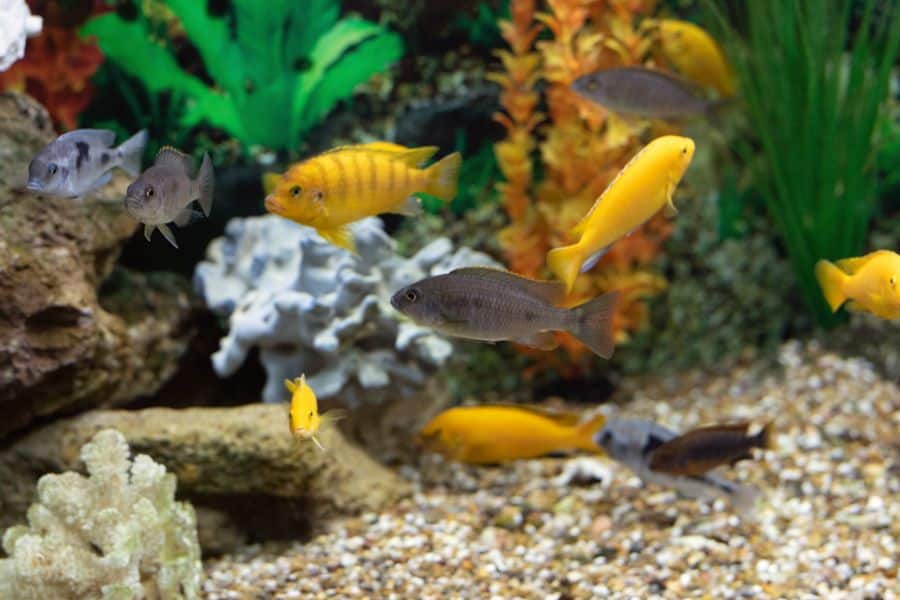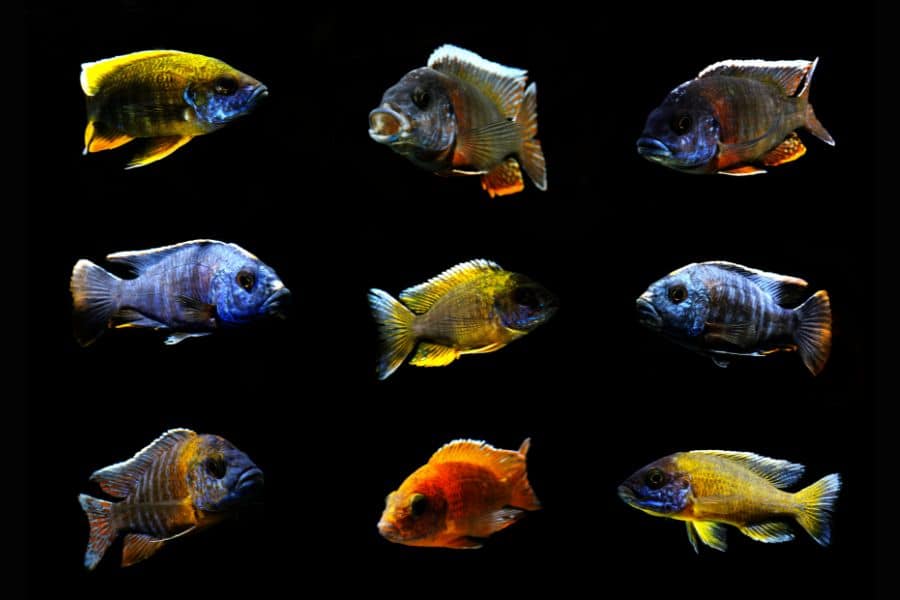African cichlids are one of the most popular fishes in the hobby, with various species being available in almost all pet shops around the country. If you want to start a new fish tank, these vibrant and active cichlids are a good option.
But before you start raising African cichlids, you must know their tank size requirements.
These fishes can be very active and territorial, plus their requirements can vary dramatically depending on their species. In this article, we’re going to talk about the best tank sizes for the most popular cichlids that you can get.
Bare Minimum Tank Size
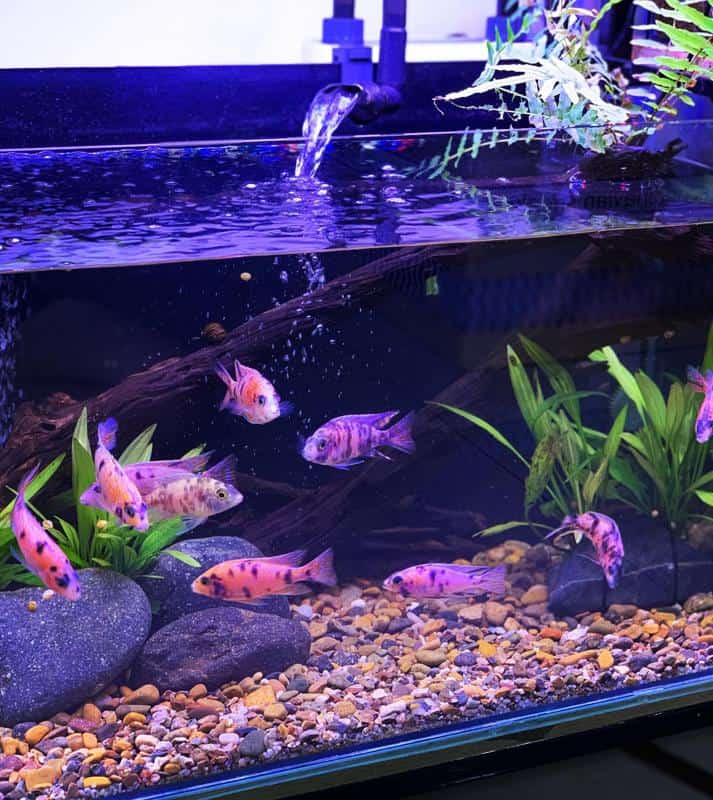
The general rule is that individual African cichlids can be kept in a minimum tank size of 30 gallons. Smaller cichlid species can be kept in a 20-gallon tank, but it should be noted that this is not ideal for their long-term health.
Additionally, experienced fishkeepers won’t recommend this at all. Keep in mind that different kinds of cichlids have different tank requirements. This is because these fishes vary a lot on crucial factors such as their size, their innate aggression, and whether or not they need a social group.
For one, most African cichlids need to be in a group setting in order to thrive, with the bare minimum being at least one mating pair.
One example is the Mbuna cichlids from Lake Malawi, which are social creatures that need other fishes to bond with. This means you need a bigger tank to house them all.
Territorial cichlids will also require a bigger aquarium, especially if you want to add them to a community tank. This is because they tend to attack any other individuals in their territory, so you need to provide plenty of space for them to roam around.
As such, 30 gallons is enough to keep your water conditions stable while giving the right amount of swimming space for the cichlid to be engaged. However, you will need to do regular cleaning and water changes to maintain the tank.
Ideal Minimum Tank Size
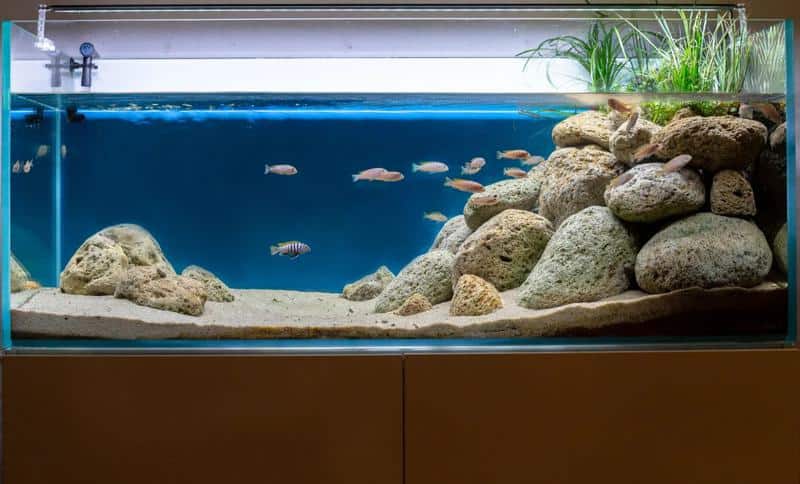
The ideal tank size for each cichlid will depend on their specific needs — but for most cichlid varieties, this is at least 55 gallons.
This water volume gives multiple cichlids enough room to swim around even as they grow to their full length.
It’s also enough for cichlids to have company without causing them any stress due to crowding. Plus, more space also provides more hiding areas for your cichlids to avoid any bullying.
Finally, it’s just enough to keep tank maintenance easy and hassle-free. A larger volume is always better, especially for a beginner aquarist, since the water conditions won’t swing as wildly.
In short, a larger body of water is always more stable and more resistant to change, allowing beginner fishkeepers to get the hang of their African cichlid tank more easily.
That said, 55 gallons is just a general guideline. The best path to take is to consider what kind of cichlid you would like to keep, research all about them, and then optimize your tank size for that.
African vs. American Cichlid Tank Size
There are many types of cichlids all around the world, and while a lot of species originated from the African continent, there are also many that are naturally found in the US.
There are crucial differences between these types of cichlids that can affect the tank size.
- Location of origin. African cichlids originated from the African continent, specifically in the three great lakes of Malawi, Victoria, and Tanganyika. On the other hand, American cichlids are mainly found across rivers in Southern and Central America.
- African cichlids tend to be very aggressive and are thus best kept away from other species of tropical fishes. They also tend to display increased aggression during their breeding periods. On the other hand, American cichlids are less aggressive and can be kept with other species.
- Average size. This will obviously depend on the species of each fish in question, but in general, American cichlids tend to grow larger than African species.
However, in the larger scheme of things, both types of cichlids will benefit from an ideal minimum of 55 gallons for one mating pair.
This is because, although African cichlids need this space due to territoriality, American cichlids tend to grow larger, so they need this swimming space.
Factors To Consider When Choosing Tank Size
You now have a good idea of what the bare minimum and ideal minimum sizes are, but maybe you want to go even larger.
This is perfectly fine as long as you factor in the following.
Expertise Level
The first thing that you have to consider is how experienced you are at keeping fish.
You will frequently read that the less experienced you are, the bigger your tank should be. This is because the water volume acts as a buffer against the changing conditions in the tank. The less the water, the less the buffer, and the more likely the conditions will affect your fish.
Thus, if you’re a beginner, you should be more inclined towards larger tanks with plenty of water volume so as to give you plenty of leeway when it comes to water parameter control.
Space
This factor is more practical than it is technical. Larger aquariums take up a lot more space in your home. While they’re largely recommended for beginners, larger aquariums (50 gallons and above) should be well planned so that they don’t impede on the daily activity in the house.
More than that, careful planning on where the aquarium will go also prevents untoward accidents or disturbances from happening to it.
For example, without careful planning, you may end up placing the tank in a spot that may experience frequent vibrations or be exposed to direct sunlight, both of which are detrimental to the health of your fish.
This is why you need to think about where your aquarium will go and the space you have available before deciding on tank size.
Budget
The next factor that you should consider is your budget.
Larger tanks are always more costly than smaller tanks. This isn’t just because of the thicker glass. You also need more expensive equipment, larger filtration systems, and bigger water changes.
This means you need to balance the size of your aquarium tank with the amount that you have budgeted for that particular project.
Cichlid Type
Lastly, you should keep the kind of cichlid you want in mind when thinking about the size of the tank that you’re choosing.
As mentioned above, tank size requirements can vary depending on the kind of cichlid that you plan to raise. This typically revolves around three factors, which are the following.
Average Adult Size
Obviously, the larger the cichlid, the bigger the tank you need.
Thus, it’s important that you first research the kind of fish that you want to put in your tank. Remember that they’re typically only juveniles when they’re sold in the pet shop, which means they can still grow significantly in size once they reach adulthood.
Also, keep in mind that their average size is just a baseline – some fishes can grow bigger than their predicted average sizes, especially if they’re raised in ideal conditions. It’s best to choose a bigger tank than predicted, just to be sure.
Temperament
The more aggressive a fish is, the larger your tank should be. Cichlids can easily get aggressive, mostly because of their territorial tendency and strong behavioral changes when breeding.
Some cichlids have purely carnivorous diets and won’t hesitate to prey on smaller species that get in their way.
A larger tank is essential for more aggressive cichlid species so that their tank mates have plenty of space to still enjoy their tank without being harassed by a dominant cichlid in the tank.
Plus, it should have plenty of hiding spots where bullied fish can seek refuge – and where easily-angered cichlids can destress.
Group Behavior
While it’s certainly possible to keep an African cichlid alone, it’s recommended to keep most species as a group, or at least as a mating pair.
African cichlids are usually communal species that live in large shoals or schools in the wild. Although their schooling drive isn’t as strong as other fish types, they still thrive better if there’s at least one other of their own kind around.
This means that you need to consider the number of cichlids that you plan to keep when choosing the size of your tank. If you intend to keep a bigger group, then it’s best to pick out a larger aquarium so that they can all fit in.
Here are some African cichlids that do best in a group setting:
- Mbuna Cichlids
- Peacock Cichlids
- Haplochromis Cichlids
- Frontosa Cichlids
Again, you need a bigger tank for these species to truly be comfortable.
Table of Popular African Cichlids and Minimum Tank Size
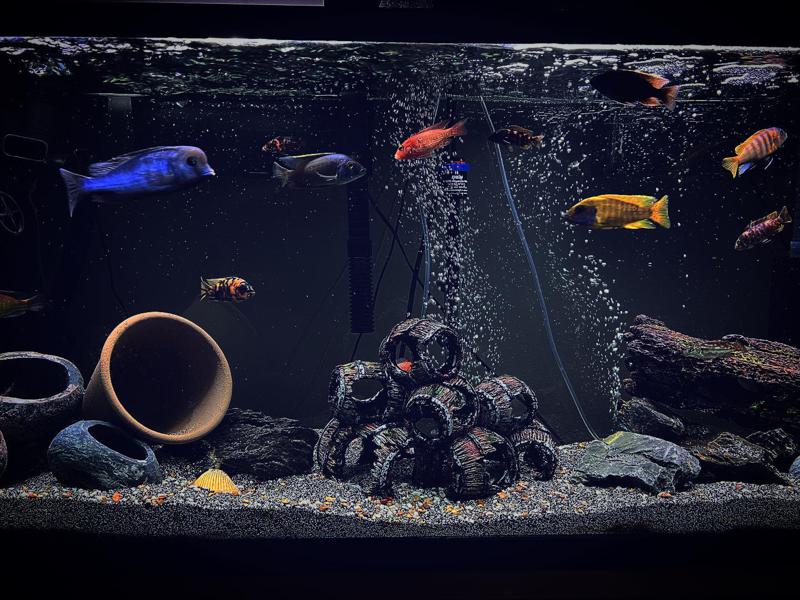
Now that you know what to look for when choosing the size of your cichlid tank, here is a table that outlines some of the most popular African cichlid species, their average adult size, and their recommended tank size.
| Species Name | Scientific Name | Cichlid Type | Average Adult Size | Minimum Tank Size |
| Electric yellow lab | Labidochromis caeruleus | Lake Malawi | 4 in | 30 gal |
| Electric blue hap | Sciaenochromis fryeri | Lake Malawi | 6.5 in | 70 gal |
| Kribensis cichlids | Pelvicachromis Pulcher | West Africa | 4 in | 30 gal |
| Frontosa cichlids | Cyphotilapia frontosa | Lake Tanganyika | 12–14 in | 85 gal |
| Peacock cichlids | Aulonocara | Lake Malawi | 4–6 in | 55 gal |
| Duboisi Cichlid | Tropheus duboisi | Lake Tanganyika | 5 in | 75 gal |
| Auratus Cichlid | Melanochromis auratus | Lake Malawi | 4-5 in | 55 gal |
| African Butterfly cichlid | Anomalochromis thomasi | West Africa | 2.5-3 in | 30 gal |
| Zebra cichlids | Pseudotropheus zebra | Lake Malawi | 4-5.5 in | 55 gal |
| Jewel cichlids | Hemichromis sp. | West Africa | 3-6 in | 40 gal |
| Fairy cichlids | Neolamprologus brichardi | Lake Tanganyika | 2.5-3.5 in | 20 gal |
| Acei Cichlid | Pseudotropheus acei | Lake Malawi | 5-7 in | 55 gal |
| Lionhead Cichlid | Steatocranus casuarius | West Africa | 4.5 in | 55 gal |
| Blue dolphin cichlid | Cyrtocara moorii | Lake Malawi | 10 in | 75 gal |
| Giraffe cichlids | Nimbochromis venustus | Lake Malawi | 8-10 in | 150 gal |
| Maingano Cichlid | Melanochromis cyaneorhabdos | Lake Malawi | 4 in | 55 gal |
| Livingston’s Cichlid | Nimbochromis livingstonii | Lake Malawi | 10 in | 125 gal |
| Emperor Cichlid | Boulengerochromis microlepis | Lake Tanganyika | 30-36 in | 300 gal |
| Red Empress Cichlid | Protomelas taeniolatus | Lake Malawi | 4.5-6 in | 7.5 gal |
| Kenyi Cichlid | Metriaclima lombardoi | Lake Malawi | 6 in | 75 gal |
| Daffofil Cichlid | Neolamprologus pulcher | Lake Tanganyika | 4-5 in | 20 gal |
African Cichlid Tank Setup Guide
Now that you know the basics of tank size for different species, you might want to establish your own tank. In this section, we’ll cover a few of the basics to make sure your African cichlid tank stays healthy and happy.
Tank Equipment You Need
The list of equipment you’ll need to set up your African cichlid tank will largely depend on the size and type of fish you’ll be keeping. Some of the essential equipment includes a tank, filter, heater, lighting, substrate, and decorations.
- African cichlids produce plenty of waste, which means a good filtration system is necessary if you want to keep your tank clean at all times. The best types of filters for them are power filters with biological, mechanical, and chemical filtration.
- African cichlids, like most tropical fish, prefer a soft substrate that won’t scratch the delicate scales of their bodies. This is especially true for species that like digging in the sand, such as Frontosa cichlids. Aquarium sand or crushed coral are good options for African cichlid tanks.
- If you live in a colder climate, you need to have a heater to keep the tank temperature stable. African cichlids are used to tropical temperatures, which means you should aim for a temperature of between 74º–82º Fahrenheit or 23º–28º Celsius.
- African cichlids don’t require any special type of lighting, so you can opt for the standard aquarium lights. However, if you have some that enjoy digging or sifting through the substrate, you might consider adding a low light to promote this behavior. Also, LED lights are much more energy efficient and last longer than traditional aquarium lights.
- Decorations can benefit your African cichlid tank in many ways. Rocks, driftwood, live plants, and artificial plants can provide fish with hiding spots, which is especially important for territorial species. Additionally, the decorations can add to the aesthetic beauty of your tank. Just make sure that any decorations you add are safe for aquarium use and don’t contain any sharp edges.
Ideal Water Conditions
It’s important to make sure that the water conditions in your African cichlid tank are ideal for them. African cichlids are used to living in hard, alkaline water. The ideal pH range is between 7.5 and 8.5, while the hardness should be between 10 and 15 dGH.
It’s also important to make sure that the water is clean and free of ammonia, nitrite, and nitrate. A good filtration system and regular water changes are essential for keeping the tank clean.
Setting Up An African Cichlid Tank
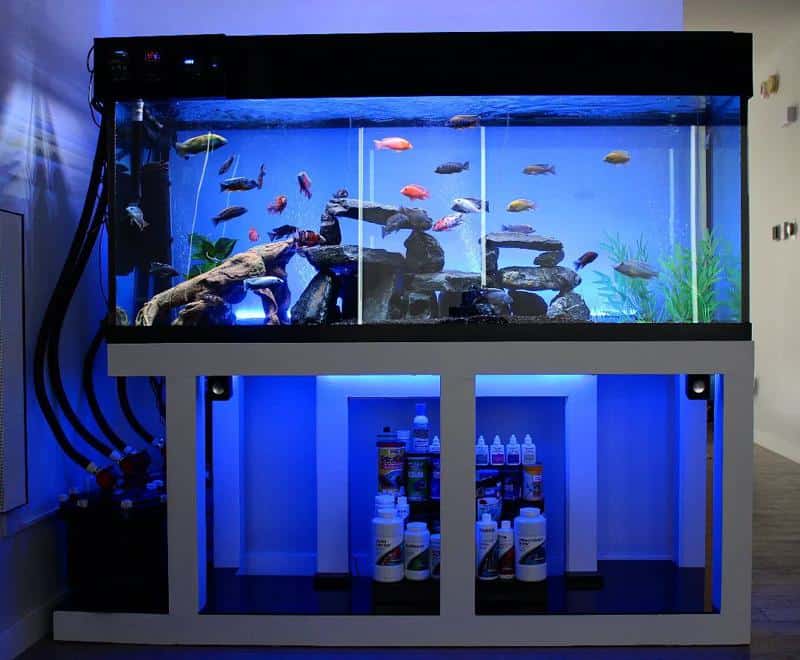
Setting up an African cichlid tank can be a bit daunting, especially if you’re new to fishkeeping.
But don’t worry, with some careful planning and research, you can create a beautiful and healthy tank for your African cichlids.
- Choose the right tank size. It’s better to err on the side of caution when it comes to tank size; the bigger, the better. This will give your fish more swimming space and provide them with plenty of room to establish their territories.
- Choose a suitable location for the tank. Avoid areas that are prone to temperature fluctuations, direct sunlight, and vibration.
- Add all the tank equipment. This includes the filter, heater, lighting, substrate, and decorations. Make sure everything is installed correctly and working properly before adding any fish to the tank.
- Add water to the tank. When adding water to the tank, make sure it has been dechlorinated and is at the correct temperature.
- Cycle your tank. Cycling a new tank is essential, as it helps to build up beneficial bacteria colonies that will help break down fish waste and keep the water parameters stable.
- Add your fish. Once the tank has been cycled, it is safe to add your African cichlids. Introduce them slowly and make sure they are all compatible with each other.
- Monitor the water parameters regularly. Regular water parameter tests are important to make sure the water remains healthy and stable.
Related:
- How Long Do Different Cichlid Species Live?
- Best Cichlid Tank Mates
- Severum Cichlid: Types, Care, Tank Mates
- Goldfish Tank Size
FAQs
Are Cichlids Good for Beginners?
Cichlids can be more aggressive, active, and fragile than other kinds of tropical fishes. This doesn’t mean that beginners can’t raise them successfully – but this does mean that beginners should take plenty of care so that they don’t overlook one aspect of the fish in their research.
What Tank Size Do Cichlids Need?
The specific ideal tank size depends largely on the species of the cichlid that you plan to raise. Thus, the best course of action is to thoroughly research the cichlid that you want to keep. Aside from that, though, a tank size of 55 gallons and above is considered ideal for many kinds of cichlids.
Should Cichlids Be Kept Together?
Many cichlid species, especially African cichlids, should be kept in a single species tank. This is because they tend to get aggressive and territorial to other types of tropical fishes.
However, there are still plenty of cichlid types that get along in community tanks, such as Bolivian rams and kribensis cichlids.
Will Cichlids Breed in A Community Tank?
Some cichlids can breed in a community tank, although the specifics depend on the exact species. Most species will breed if they have good tank conditions, and pairing will happen naturally. However, some species need to be stimulated by outside factors for them to breed.
Do Cichlids Grow to The Size of Their Tank?
Cichlids can outgrow their tank. That said, their growth typically slows down before they are a year old. The exact size at which they stop growing, however, depends on the species of cichlid— some may stop growing at 6 inches, while other may keep growing past a foot.
Final Thoughts
African cichlids are some of the most popular types of fish in the aquarium hobby — and no wonder. They are colorful, full of personality, and absolutely enchanting to watch.
However, it’s important that their tank is kept in the best possible condition.
In this article, you learned how to create the ideal African cichlid tank — from choosing the right tank size, to adding all the necessary equipment, cycling the tank, and everything else you need to know.
By following all of these steps, you can ensure that your cichlids have a healthy and comfortable home.
